Wisconsin
| |
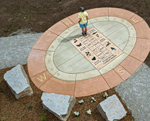 |
Janesville |
Wisconsin |
USA |
Analemmatic Dial |
Dial 1065 |
| This 21 ft x 16 ft (7m x 5m) analemmatic sundial has a landscaped area with seating and a stone pier that holds a bronze dedication plaque and a bronze information plaque with a QR code for additional online information. The central zodiac walkway is a 2,500 pound pre-cast concrete slab that includes images of regional plants and animals next to their corresponding months to represent seasonal cycles as a reminder that nearly all life on earth is connected to the relative motions and positions of the sun and earth. The bronze hour numerals and bronze cardinal point letters are anchored into poured concrete rings that surround the walkway. The analemmatic sundial is modeled after the one at the Milwaukee County Botanical Domes. |
| |
| |
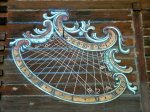 |
Kohler Village |
Wisconsin |
USA |
Vertical Dial |
Dial 290 |
| A direct east vertical dial approximately 5 feet square, ornately painted onto the side of the Waelderhaus at Kohler Village. The Waelderhaus is a tribute to the tradition of Bregenzerwald, a province of Vorarlberg, Austria, and represents the architecture of this particular Alpine Area. The dial is painted in gold and white with flourishes. A top scroll shows hours with Arabic numerals while a bottom scroll shows the hours with Roman numerals. Lines for solstice, equinox, and signs of the zodiac are drawn across the faces of the dial. No analemma is drawn. |
| |
| |
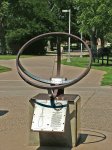 |
La Crosse |
Wisconsin |
USA |
Equatorial Dial |
Dial 217 |
| A 40 inch diameter armillary on a 2 foot tall cement cubic base. The original analemma-shaped gnomon was missing and replaced with a section of loose ordinary electric wire. Includes a longitude-correction plaque showing the corrections throughout 15 degrees longitude. Dial sits atop a 26 inch high, 26 inch square pedestal. Robert Allen states that this dial is a scaled down version of the one at the San Diego Zoological Garden, and that there is a similar one at Williams College in Williamstown MA. |
| |
| |
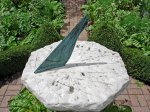 |
Madison |
Wisconsin |
USA |
Horizontal Dial |
Dial 729 |
| An octagonal limestone horizontal dial with bronze gnomon. Hour lines are hand chiseled with no hour numerals. The noon line includes an inset bronze triangle.
Viewing the dial within the garden requires an admission fee. |
| |
| |
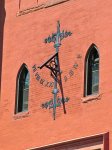 |
Milwaukee |
Wisconsin |
USA |
Vertical Dial |
Dial 381 |
| A direct south cast or wrought iron vertical dial on a brick building. |
| |
| |
 |
Milwaukee |
Wisconsin |
USA |
Vertical Dial |
Dial 841 |
| This large vertical south facing sundial is fabricated from aluminum. Eight slender hour lines delineate the time. At the top of the hour lines along the winter solstice are acrylic numbers on the circular hour plates showing time from 10am to 5pm. At the bottom of the hour lines along the summer solstice are additional acrylic numbers showing daylight saving time from 11am to 6pm. A short horizontal bar shows the equinox. |
| |
| |
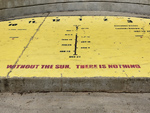 |
Milwaukee |
Wisconsin |
USA |
Analemmatic Dial |
Dial 1000 |
| During the design of the bridge across the lagoon, the walkway was extended in the center on the north side, creating a niche for a 12 x 6 foot analemmatic dial. The dial is painted bright yellow with hours marked from 5am to 9pm (daylight saving time). The 1pm hour mark is set 8 1/2 minutes past local noon corresponding to its location just east of the Central Time Zone meridian. The walkway is marked with a central line using tic marks for each month and solstices. As of 2019, the paint is well worn. The dial has red circular Bailey marks for observing the direction of sunrise and sunset. Latitude and longitude are painted on the dial as well. At the north side of the dial on bridge railing is a sign explaining how to stand on the dial and use the equation of time chart to get civil time |
| |
| |
 |
Milwaukee |
Wisconsin |
USA |
Analemmatic Dial |
Dial 1066 |
| A large analemmatic ("human") sundial with bronze zodiac walkway and Arabic hour numbers. The dial also has a simple 4-point compass rose. The Horticulturalists had asked that an area of interest be created in the paved area in front of the school bus load zone. A durable and permanent solution was requested which resulted in the analemmatic dial with cast bronze numerals and a zodiac walkway cast in two pieces. Douglas Hunt, a scientist in Scotland determined the layout of the numeral locations and dates of the zodiac walkway. The site work was designed by County staff engineer Julie Bastin and Ruvin Bros construction completed the installation. |
| |
| |
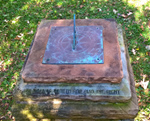 |
Nashotah |
Wisconsin |
USA |
Horizontal Dial |
Dial 845 |
| In a quite, shaded corner of the Nashotah House Theological Seminary is a copper alloy horizontal dial. The dial plate is a 10 inch square, 3/32 inches thick. The dial is engraved with several concentric circles with with large Roman hour marks on an outer ring from 5am to 7pm. Time is delineated in 5 minute increments on the outer circle, but includes an inner circle delineated in 15 minute increments. In the center of the dial is an 8-point compass rose with engraved directions. The quarter inch thick brass gnomon is a simple raised bar acting as style with an "S" shaped support. |
| |
| |
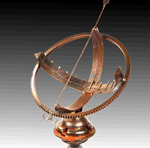 |
New Berlin |
Wisconsin |
USA |
Equatorial Dial |
Dial 865 |
| This whimsical yet elegant equatorial dial is made from old farm implements. The materials are high carbon steel and cast iron parts. The 18-inch gear is a flywheel from an International Harvester farm tractor. The base is a harrow blade for tilling soil. The harrow blades ride on a square shaft and the blades are separated by spacers seen the base of the sundial. The meridian arcs are soil tillers that would ride on a drum behind the tractor. These pieces are very challenging to weld because they are dissimilar materials. Horseshoe nails mark the hours on the equatorial arc. No hour numbers are used, just the nails. The gnomon is an arrow rod. |
| |
| |
 |
River Falls |
Wisconsin |
USA |
Vertical Dial |
Dial 185 |
| The inspiration for this sundial, at one time the largest vertical dial in the world, came from Dr. Swensen visiting Heidelberg castle that had a large vertical dial on the wall of the castle. Construction of the Univ. of Wisconsin dial began in 1994 on the south wall of the Kleinpell Fine Arts Building. The result is a 30 x 56 foot vertical dial of anodized aluminum with analemmic hour markers, and day lines to mark winter and summer solstice, Candelmas (1/31), Martinmas (11/10), Beltane (5/8) and Lammas (8/4), vernal and autumnal equinoxes. The massive south-facing vertical dial takes up the entire wall of the three-story fine arts building. The hour markers are gold on the 'Spring' side and brown on the 'Fall' side with 7 day intervals marked on each. |
| |
| |
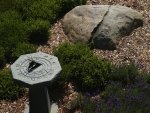 |
Sheboygan Falls |
Wisconsin |
USA |
Horizontal Dial |
Dial 550 |
| A 20 inch octagonal dial of bluestone on a 28 inch high base. The gnomon matches the latitude angle and the hour lines are approximate for a generalized geographic area. |
| |
| |
 |
Waukesha |
Wisconsin |
USA |
Horizontal Dial |
Dial 512 |
| A large horizontal dial in a circular plaza made of tan concrete and red brick. The concrete gnomon stands about 16 feet tall. No hour lines are drawn on the plaza, but the hours are set in a circular ring at the edge of the plaza. |
| |
| |
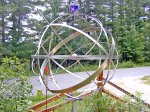 |
Westfield |
Wisconsin |
USA |
Armillary Sphere |
Dial 651 |
| A 42 inch diameter stainless steel armillary dial with central brass sphere and topped by a 100 mm cobalt blue crystal ball. The armillary includes equatorial, meridian, tropic (2), horizon and colure rings. Above the armillary is a weathervane featuring a landing bald eagle with Swarovski crystal eye. Hour markings are notched on the equatorial ring. The armillary rests on a 43 inch high tapered stainless steel pyramidal base. The overall height of the dial and weathervane is 10 feet. The dial sits on a 43 inch high, 8x8 inch tapered pyramidal stainless steel pedestal.
Dial is on private property but is visible from Fourth Avenue. Owner asks that viewers wanting closer access contact him by phone. |
| |